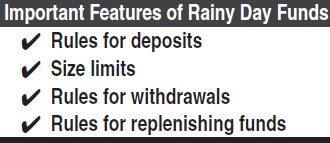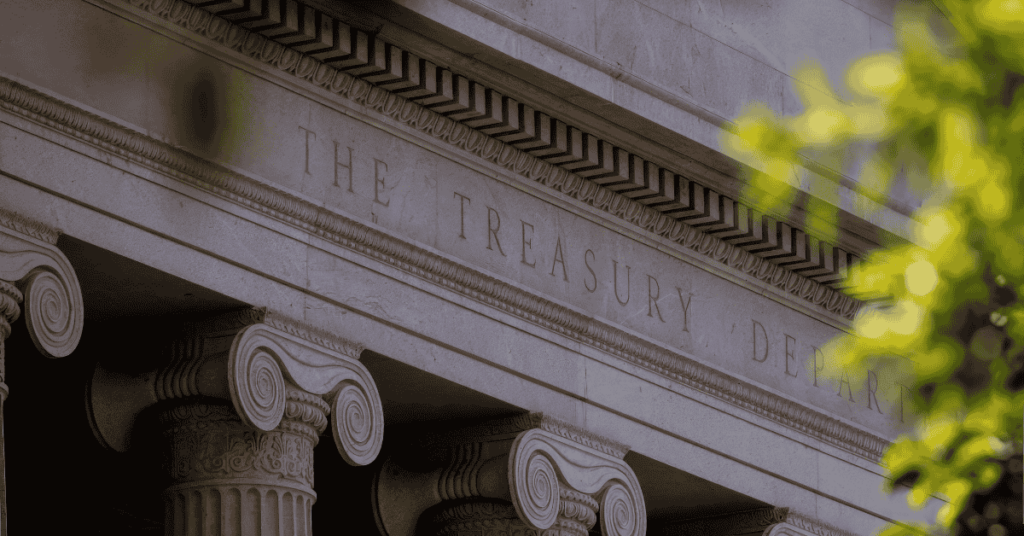In recent years, most state governments have experienced painful budget deficits. Many states have reacted to these shortfalls by cutting spending or increasing taxes. Almost all states now have a third option that can help postpone these painful decisions: using a rainy day fund (RDF). Like a savings account, an RDF sets aside surplus revenue during periods of economic growth for use in times of budget shortfalls. This policy brief takes a closer look at how rainy day funds can help states through difficult fiscal times, and assesses options for improving the adequacy of these funds.
Why Are Rainy Day Funds Needed?
Rainy day funds are an important component of a responsible state budget process for a simple reason: taxes and public spending operate on different cycles. During periods of economic growth, tax collections can exceed a state’s spending needs—creating a short term budget surplus. When the economy slows down, tax collections generally decline but the need for important public services (especially services for low- and middle income taxpayers) continues unabated, resulting in short-term budget deficits. This cyclical “boom and bust” feature of state tax systems means that budget surpluses and deficits are a regularly occurring feature of state tax systems. Even a state that makes no changes at all to its taxing and spending habits will ultimately experience shortfalls because of this cycle.
Rainy day funds smooth out the highs and lows of this cycle by setting aside surplus revenue in good years, and using these savings to offset budget shortfalls in bad years. States that have the luxury of drawing down rainy day funds during economic downturns are likely to have a more stable fiscal structure over time, because these states can balance budgets without having to constantly change their tax system and spending priorities. The ability of an RDF to effectively smooth out this budgetary cycle without tax and spending changes is a desirable feature in state fiscal structures for several reasons:
✔ Unstable fiscal structures make for a bad investment climate: when individuals and businesses don’t know whether a state will change its tax system (or the quality of its public services) during the next recession, the state becomes a less attractive place to live, work and invest.
✔ An adequate RDF makes it easier for states to borrow money for financing long-term capital investments. Bond rating agencies consistently cite healthy RDFs as a reason for giving states high bond ratings. Good bond ratings directly reduce the cost of borrowing for a state, which in turn reduces the cost of providing public services in the long run.
✔ Rainy day funds allow policymakers to avoid fiscal policy decisions that can worsen economic downturns. When budget shortfalls are caused by short-term economic declines, tax hikes or spending cuts can actually prolong the economic slump.
Designing an Effective Rainy Day Fund

The recent nationwide recession has shown that some rainy day funds are more effective thanothers. This section looks at important features of state rainy day funds.
☞ How is money deposited into the fund? Most states specify conditions under which deposits will be automatically made. The most common approach is to link RDF deposits to a state’s year-end budget surplus. Texas requires that half of any year-end surplus be devoted to its RDF. However, this process is not as automatic as it sounds: because deposits are made at the end of the year, every other spending priority of state lawmakers comes first. Lawmakers can avoid depositing revenues in the RDF by simply spending all surplus revenues before the end of the fiscal year.
A more effective approach is to require that some revenue must be deposited during any year when state revenues grow by some minimal amount. For example, Indiana requires that revenues be deposited in its RDF in any year when income grows by more than two percent. This approach ensures that deposits will be made. However, if the threshold for depositing revenues is too low, lawmakers may be forced to deposit revenues in the RDF at a time when they cannot afford to.
A few states have no rules specifying conditions when RDF deposits must be made, and simply allow lawmakers to deposit revenues when it suits them. The main shortcoming of this approach is that these RDF’s are much more likely to be chronically underfunded.
☞ Is there a limit on the size of the fund? Almost all states impose some limit on the amount of revenue that can be put in their rainy day funds. A commonly cited rule of thumb has been that a fund capped at five percent of a state’s budget should be sufficient to ride out an economic downturn. Almost half of the states with rainy day funds now cap their fund at 5 percent of their budget or less. A few states impose a cap of more than 10 percent, and 13 states have no limit at all. While many states have used the 5 percent limit as a rule of thumb, the recent experience of these states suggests that a 5 percent limit is simply insufficient to cope with the extended economic shortfalls that many states have experienced in recent years. A higher cap of at least 10 percent could help states use these funds properly in the next recession.
☞How is money withdrawn from the fund? In most states, a simple majority of lawmakers can vote to use the RDF. However, some states require a supermajority of 60 percent or more. Many states also limit the total amount that can be withdrawn in any year. All such limits make RDFs less flexible as a fiscal policy tool—and increase the likelihood that state lawmakers will have to rely on tax hikes or spending cuts to get through a recession.
☞Is there a replenishment rule? Some states require any RDF withdrawals to be paid back promptly. For example, Rhode Island requires any withdrawals from its RDF to be replaced within two years. This constraint can reduce the usefulness of rainy day funds: if lawmakers must promptly replenish these funds, doing so will have to compete with other spending priorities—forcing exactly the sort of painful spending cuts that RDFs are designed to prevent.
An Important Tool For Dealing with Cyclical Deficits
An adequate, accessible rainy day fund can help state lawmakers to avoid enacting painful tax increases or cuts in public services by providing a third option—drawing down the state’s savings account to get through tough times. But rainy day funds should only be used to reduce the impact of budget shortfalls that arise from cyclical economic downturns—not to cope with long-term structural problems. In particular, states in which the tax structure is simply inadequate to fund public services over the long run should look to structural tax reform as a solution rather than relying on rainy day funds to balance their budgets.





